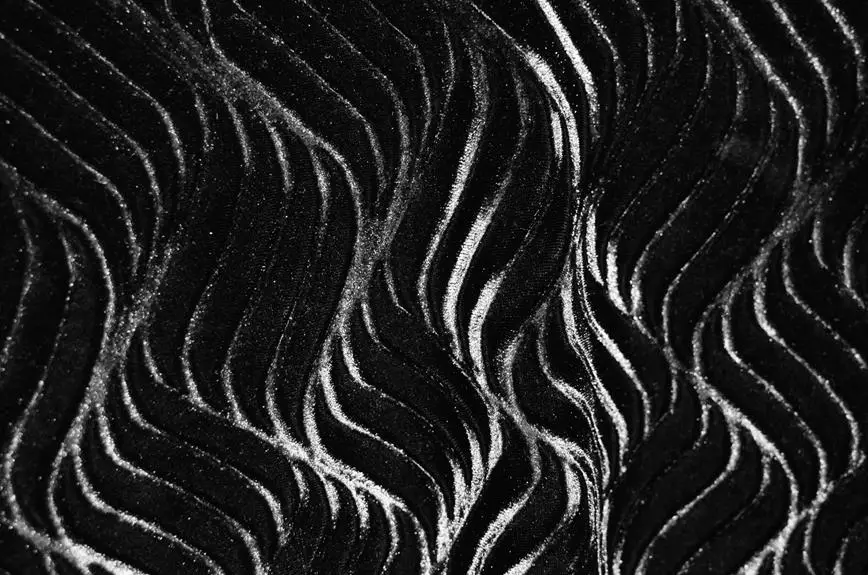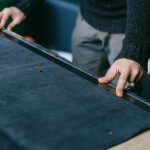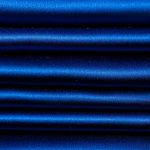You may think mastering the French curve is a daunting task, but with these 5 tips, you'll be confidently manipulating fabrics like a pro.
Understanding the intricacies of using a French curve with fabrics can elevate your pattern-making and garment construction skills to a whole new level. By incorporating precision, control, and an understanding of fabric behavior, you can achieve flawless curves and smooth lines in your designs.
Whether you're a seasoned seamstress or a budding fashion designer, these tips will help you harness the full potential of the French curve for creating impeccable patterns and alterations.
Key Takeaways
- Choose the appropriate French curve for the design and pattern.
- Align the French curve with the grainline of the fabric for proper draping.
- Practice precision and control when using the French curve on different fabrics.
- Use marking tools such as tailor's chalk and tracing wheel for accuracy in pattern alterations.
Choose the Right French Curve for the Job
When selecting a French curve for your fabric projects, start by choosing the appropriate curve for the specific design or pattern you're working with. Choosing the proper curve is essential for achieving accurate and smooth lines in your fabric manipulation techniques.
Different French curves are designed to suit various shapes and angles, so it's crucial to match the curve to the curves and lines present in your pattern. For gentle, flowing curves, a larger French curve would be more suitable, while smaller, tighter curves require a smaller curve. Consider the intricacy of your design and the scale of your project when making your selection.
Additionally, some French curves are designed with cutouts or cutaway sections to facilitate ease of use on fabric. These features can be particularly helpful when working with thicker fabrics or when maneuvering around existing seams.
Understand the Grainline and Fabric Draping
To accurately use a French curve with fabrics, you need to understand the grainline and fabric draping. Understanding the grainline is crucial as it refers to the direction of the threads in a fabric and plays a significant role in how the fabric behaves. When using a French curve for garment construction, it's important to align the curve with the grainline to ensure that the pattern or design follows the natural drape of the fabric. Additionally, being familiar with fabric manipulation and draping techniques allows you to create more intricate and tailored designs. Below is a table outlining key concepts related to grainline and fabric draping:
| Grainline | Fabric Draping |
|---|---|
| Refers to the direction of the threads in a fabric | Involves shaping and manipulating fabric to create specific designs |
| Crucial for ensuring the proper drape and fit of a garment | Utilized in creating patterns and prototypes for garments |
| Aligning patterns with the grainline is essential for garment construction | Understanding bias and grainline ensures that the fabric falls and drapes naturally |
Understanding these concepts will enable you to utilize a French curve more effectively when working with fabrics, leading to more precise and professional results in your garment construction.
Practice Precision and Control
Improve your garment construction precision and control by practicing with a French curve on various fabrics.
Precision techniques are essential in achieving accurate and professional-looking garment construction. When using a French curve, pay attention to the exact placement of the curve on the fabric. Ensure that the curve aligns perfectly with the pattern or design you're working on.
Practice drawing and connecting lines with the French curve to develop a steady hand and consistent control.
Fabric manipulation is another aspect to consider when practicing precision and control. Different fabrics may require varying levels of manipulation when using a French curve. Thin and delicate fabrics may need a lighter touch, while thicker fabrics may require a firmer hand.
Practice on a variety of fabric types to develop a keen sense of how to manipulate the fabric to achieve precise and controlled lines.
Use Marking Tools for Accuracy
Develop a steady hand and consistent control by using marking tools for accuracy when using a French curve with fabrics. Precision tools are essential for achieving accurate and clean lines in fabric manipulation. Here are some essential marking tools to enhance your precision and control:
- Tailor's Chalk: This tool provides clear, easily removable markings on fabric, allowing for precise adjustments and alterations.
- Tracing Wheel: Use a tracing wheel in conjunction with carbon paper to transfer intricate pattern markings onto fabric with great accuracy.
- Disappearing Ink Pen: This pen allows you to make temporary marks on fabric that vanish over time or with the application of heat, ensuring precision without leaving any permanent traces.
- Seam Gauge: A seam gauge aids in measuring and marking hems, seam allowances, and pleats accurately, resulting in professional-looking finishes.
Incorporate French Curve Techniques Into Pattern Alterations
Incorporate French curve techniques into pattern alterations by refining your precision and control with the use of marking tools, ensuring accurate and clean lines in fabric manipulation. When it comes to pattern shaping and altering, the French curve can be an indispensable tool for achieving smooth and precise lines. By incorporating French curve techniques into your pattern alterations, you can ensure that your garment alterations are not only accurate but also visually appealing. The French curve allows for seamless transitions between different curves and angles, resulting in a more professional and polished look for your patterns.
To further understand the significance of incorporating French curve techniques into pattern alterations, consider the following table:
| Benefits of French Curve Techniques in Pattern Alterations |
|---|
| Enhanced Precision and Control |
| Seamless Transitions in Curves and Angles |
| Professional and Polished Look for Patterns |
Frequently Asked Questions
Can a French Curve Be Used on All Types of Fabrics, or Are There Certain Fabrics That It Works Best With?
French curves work best with medium to heavyweight fabrics. They are ideal for creating smooth, curved lines on materials like wool, cotton, and denim. Use caution with delicate or stretch fabrics to avoid distortion.
How Do You Clean and Maintain a French Curve to Ensure Its Longevity and Accuracy?
To maintain a French curve's accuracy and longevity, clean it regularly with a damp cloth and mild soap. Avoid harsh chemicals that may damage the material. Store it in a protective case or drawer to prevent bending or scratching.
Are There Any Specific Tips for Using a French Curve on Stretch Fabrics or Knits?
When working with stretch fabrics, using a French curve requires finesse. Ensure the curve accommodates the fabric's stretch by gently manipulating it. Practice precise French curve techniques for stretch fabrics to achieve accurate, smooth lines on your knit projects.
Can a French Curve Be Used for Creating Curves on Non-Garment Items, Such as Accessories or Home Decor Projects?
Yes, a French curve can be used for creating curves on non-garment items such as accessories and home decor projects. It's also handy for leatherworking, woodworking, and upholstery, providing precise curves for artistic projects.
What Are Some Common Mistakes to Avoid When Using a French Curve With Fabrics, and How Can They Be Corrected?
When using a French curve with fabrics, common mistakes include not properly aligning the curve, causing inaccurate cuts. Correct this by double-checking alignment. Also, not maintaining a clean curve can lead to uneven lines. Regularly clean and store the curve properly.
- Tetron Fabric for Marine Applications: Durability and Use Cases - June 18, 2025
- Tetron Fabric for Outdoor Furniture: Weather Resistance and Care - June 18, 2025
- Tetron Fabric for Wall Coverings: Style and Application Tips - June 18, 2025






